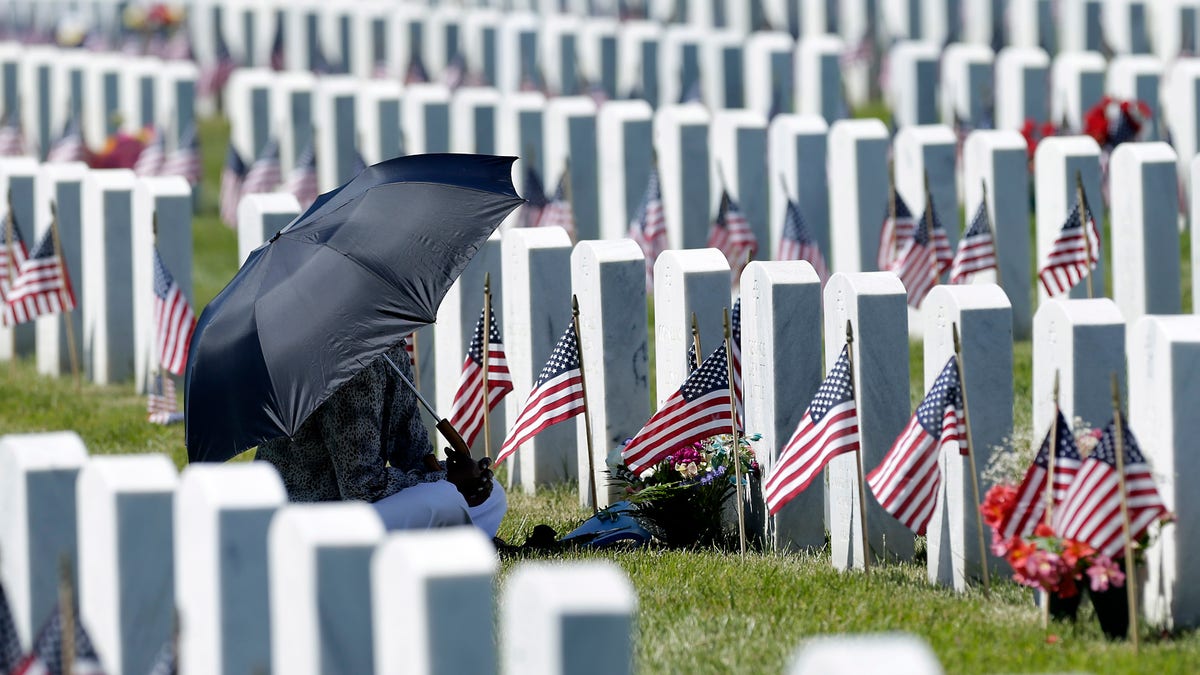Don't forget what Memorial Day is really about
{{#rendered}} {{/rendered}}
FILE -- Paulette Little visits the grave of her late husband George Little, a Navy veteran, during Memorial Day observances at the Sacramento Valley National Cemetery. (AP Photo/Rich Pedroncelli)
This Memorial Day weekend, Americans are enjoying the warm weather, cookouts and all sorts of outdoor recreational opportunities as we spend time with family and friends.
Statistics compiled by WalletHub tell us that 60 percent of Americans are eating at barbecues, beer sales will be higher than any day except the Fourth of July, 41.5 million people are traveling, and about 41 percent of us are taking advantage of Memorial Day sales.
Oh, and by the way, more than 200,000 American flags have been placed on graves in a large cemetery facing our nation’s capital, the heart of a holiday that honors the more than 1.3 million Americans who have died in our nation’s wars.
{{#rendered}} {{/rendered}}I live in Arlington, Virginia. Many know it as a highly urbanized suburb of Washington – home to federal government workers, lobbyists, defense contractors and a host of other members of the Washington infrastructure.
Yet Arlington County’s dense housing has a major open space, just like New York City’s Manhattan. However unlike Central Park’s use as a place for recreation, Arlington’s open space is Arlington National Cemetery, where the graves of over 400,000 service members, veterans and their relatives are buried in eternal remembrance.
I recently had the chance to stroll again through America’s “most sacred place.” With the rolling hills dotted by seemingly innumerable graves, my heart grew heavy as I walked among them.
{{#rendered}} {{/rendered}}The graves hold members of the military who served from the Civil War to Operation Iraqi Freedom. Every rank from the lowest to the highest is represented. Some of those buried in Arlington died young, on active duty. Some died old, decades after leaving the military.
The religious symbols inscribed on the gravestones included the Latin Cross, Star of David, Star and Crescent and more. Some have no religious symbols. The names represent people with origins from all over the planet, reminding us why it is often said that the U.S. military is the world’s most diverse organization.
What all these graves have in common, however, is the reason why those buried there were interned for perpetuity on land previously owned by both the Washington and Lee families before becoming a cemetery in the 1860s. These men and women took an oath to the Constitution and served our country and each other with honor, dignity and courage.
{{#rendered}} {{/rendered}}As our nation celebrates Memorial Day on a beautiful weekend, we should take the opportunity as well to reflect on the sacrifice of the members of our armed forces who gave their lives so we can enjoy freedom and prosperity in the greatest human experiment ever known.
We should also take time to reflect on what we can do for those currently serving, the veterans who have returned home, and the future soldiers, sailors, airmen and Marines of our republic.
There are worrying signs of the increasing civilian-military divide in America.
{{#rendered}} {{/rendered}}Despite the military being by far the most respected institution in our country, recent polling has shown that fewer Americans are serving in the military compared to past generations, and far fewer Americans now even know anyone who has served in the military.
According to Pew Research, in 2016 veterans accounted for only about 7 percent of U.S. adults. In comparison, in 1980 they were 18 percent.
Even among our nation’s leaders a stark change has happened. In 1953 – just eight years after World War II ended – 74 percent of members of the U.S. Senate and 62 percent of members of the House of Representatives were veterans. But last year, only 20 percent of senators and 19 percent of House members were veterans.
{{#rendered}} {{/rendered}}Fewer veterans in Congress means there are fewer members who understand from first-hand experience the difficulties that veterans face – both in dealing with the Department of Veterans Affairs on their health-care needs and with other issues connected to their service.
Many of us are familiar with the Department of Veteran Affairs’ scandal, in which veterans were found to not be given their health-care appointments on time and with perhaps as many as 307,000 veterans dying while they awaited health-care appointments, according to a government investigation.
There also is the complex and elusive problem of post-traumatic stress syndrome (PTSD), which affects as many as 31 percent of Vietnam veterans, 11 percent of Afghanistan veterans, and 20 percent of Iraq War veterans. It also is a contributing factor to veteran homelessness and elevated veteran suicide rates, estimated at up to 22 a day.
{{#rendered}} {{/rendered}}Even those veterans who return from service with their minds and bodies intact face struggles ranging from a skills gap to civilians not understanding their experience.
This Memorial Day weekend is undoubtedly a joyful time for many millions of Americans across this great nation of ours. However, it is more than worth a moment of our time to reflect on all that has been given so that we can enjoy our entire way of life, as well as what we can do to help those currently alive and serving or who have served.
This is the very least we can do, and it is up to us to now provide that helping hand and warm embrace in return for their sacrifices.
